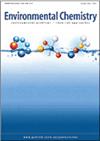苔藓和地衣促进亚热带山地森林大气元素汞沉积
IF 2.3
4区 环境科学与生态学
Q3 CHEMISTRY, ANALYTICAL
引用次数: 0
摘要
苔藓和地衣广泛分布于山地森林中,在全球生物地球化学循环中的重要作用日益得到人们的认识。这项利用汞同位素数据对苔藓和地衣中汞积累和来源的研究提供了证据,证明它们促进了这些森林中的大气汞沉积,这是一个重要的功能,应该纳入目前的森林汞质量平衡预算。理由:广泛分布于山地森林的苔藓和地衣常被用来监测大气中汞的沉积。在本研究中,我们假设苔藓和地衣对大气中汞的吸收可以极大地促进山地森林中汞的沉积。方法综合测定亚热带山地森林中不同种类苔藓地衣的汞浓度和同位素特征,量化苔藓地衣对汞的积累、影响因素和潜在的汞沉积。结果苔藓中汞含量高于地衣主要是由于种类、形态和生理上的差异。Hg同位素混合模型结果表明,大气单质Hg (Hg0)对苔藓和地衣的贡献分别为89.2±22.8%和88.4±24.4%。生长在树上的地衣对大气Hg源的贡献(61.3±42.5%比93.6±10.0%)低于生长在地上的地衣,这是因为树木对降雨Hg的吸收增加了。苔藓和地衣中Hg的储存量分别为28.0±16.5和0.9±1.0 μ m−2。考虑到苔藓1 ~ 2年的寿命,苔藓诱导的大气汞沉降几乎相当于以前被用作森林大气汞沉降的替代物的凋落物汞沉降。综上所述,我们认为苔藓和地衣在大气汞沉积中起着重要作用,并建议在山地森林中开展更多的研究。本文章由计算机程序翻译,如有差异,请以英文原文为准。
Mosses and lichens enhance atmospheric elemental mercury deposition in a subtropical montane forest†
Environmental context Mosses and lichens are widely distributed in montane forests and their important role in global biogeochemical cycles has been increasingly recognised. This study of mercury accumulation and sources in mosses and lichens, using mercury isotopic data, provides evidence that they promote atmospheric mercury deposition in these forests, which is an important function that should be incorporated into current mercury mass balance budgets for forests. Rationale Mosses and lichens, which are widely distributed in montane forests, are often used to monitor the atmospheric mercury (Hg) depositions. In this study we hypothesised that atmospheric Hg uptake by mosses and lichens could greatly promote Hg depositions in montane forests. Methodology We comprehensively determined the Hg concentration and isotopic signatures of various species of mosses and lichens in a subtropical montane forest, to quantify the Hg accumulation, influencing factors and potential Hg depositions induced by mosses and lichens. Results Our results show that the higher Hg concentrations in mosses than in lichens are mainly due to their species-specific, morphological and physiological differences. Hg isotopic mixing model results display that uptake of atmospheric elemental Hg (Hg0) contributes 89.2 ± 22.8% of Hg in mosses and 88.4 ± 24.4% in lichens. The lichens growing on trees have a lower atmospheric Hg0 source contribution than on the ground (61.3 ± 42.5% versus 93.6 ± 10.0%) because of the elevated rainfall Hg uptake on trees. The Hg storage in live moss and lichen is 28.0 ± 16.5 and 0.9 ± 1.0 μg m−2, respectively. Given the 1–2-year lifespan of moss, the moss induced atmospheric Hg deposition is almost equivalent to litterfall Hg deposition which was previously used as a proxy for atmospheric Hg0 deposition in forests. Discussion Overall, we suggest mosses and lichens play an important role in atmospheric Hg depositions and recommend more research in montane forests.
求助全文
通过发布文献求助,成功后即可免费获取论文全文。
去求助
来源期刊

Environmental Chemistry
环境科学-分析化学
CiteScore
4.50
自引率
0.00%
发文量
0
审稿时长
2.7 months
期刊介绍:
Environmental Chemistry publishes manuscripts addressing the chemistry of the environment (air, water, earth, and biota), including the behaviour and impacts of contaminants and other anthropogenic disturbances. The scope encompasses atmospheric chemistry, geochemistry and biogeochemistry, climate change, marine and freshwater chemistry, polar chemistry, fire chemistry, soil and sediment chemistry, and chemical aspects of ecotoxicology. Papers that take an interdisciplinary approach, while advancing our understanding of the linkages between chemistry and physical or biological processes, are particularly encouraged.
While focusing on the publication of important original research and timely reviews, the journal also publishes essays and opinion pieces on issues of importance to environmental scientists, such as policy and funding.
Papers should be written in a style that is accessible to those outside the field, as the readership will include - in addition to chemists - biologists, toxicologists, soil scientists, and workers from government and industrial institutions. All manuscripts are rigorously peer-reviewed and professionally copy-edited.
Environmental Chemistry is published with the endorsement of the Commonwealth Scientific and Industrial Research Organisation (CSIRO) and the Australian Academy of Science.
 求助内容:
求助内容: 应助结果提醒方式:
应助结果提醒方式:


